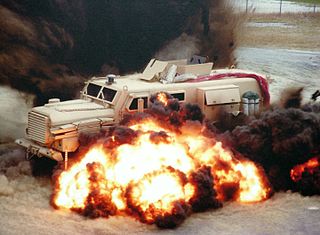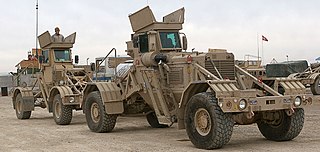
An improvised explosive device (IED) is a bomb constructed and deployed in ways other than in conventional military action. It may be constructed of conventional military explosives, such as an artillery shell, attached to a detonating mechanism. IEDs are commonly used as roadside bombs, or homemade bombs.

A combat engineer is a type of soldier who performs military engineering tasks in support of land forces combat operations. Combat engineers perform a variety of military engineering, tunnel and mine warfare tasks as well as construction and demolition duties in and out of combat zones.

The Israeli Combat Engineering Corps is the combat engineering forces of the Israel Defense Forces.

A clearance diver was originally a specialist naval diver who used explosives underwater to remove obstructions to make harbours and shipping channels safe to navigate, but later the term "clearance diver" was used to include other naval underwater work. Units of clearance divers were first formed during and after the Second World War to clear ports and harbours in the Mediterranean and Northern Europe of unexploded ordnance and shipwrecks and booby traps laid by the Germans.
The 9th Engineer Battalion is a unit of the United States Army that deploys to designated contingency areas and conducts combat and/or stability operations in support of a brigade combat team. It is a divisional mechanized combat engineer unit, composed of three line companies and a headquarters company. Its mission is to provide assured mobility, counter-mobility, general engineering, and survivability support, with well trained sappers ready to deploy anywhere at any time. The unit's history spans service in 1917 in the US southwest, World War II in France and Germany, multiple deployments to the Balkans, and multiple deployments in support of the Global War on Terrorism in Iraq and Afghanistan. It is most famous for the capture of the Ludendorff Bridge across the Rhine River. As of 18 May 2015, the battalion exists as the 9th Brigade Engineer Battalion in Fort Stewart, GA under 2nd Armored Brigade Combat Team, 3rd Infantry Division.

The Buffalo is a wheeled mine resistant ambush protected (MRAP) armored military vehicle built by Force Protection, Inc., a division of General Dynamics. It is the largest vehicle in Force Protection's line-up, followed by the Cougar MRAP and the Ocelot light protected patrol vehicle (LPPV).

The Cougar is a mine-resistant ambush-protected (MRAP) and infantry mobility vehicle structured to be resistant to landmines and improvised munitions.
Force Protection, Inc. was a manufacturer of ballistic- and blast-protected vehicles from the United States which have been used in Iraq, Afghanistan, Kosovo and other hot spots around the world. The company was acquired by General Dynamics in 2011.

An infantry mobility vehicle (IMV) is a wheeled armored personnel carrier (APC) serving as a military patrol, reconnaissance or security vehicle. Examples include the ATF Dingo, Iveco LMV, Oshkosh M-ATV, AMZ Dzik, AMZ Tur, Mungo ESK, and Bushmaster IMV. This term also applies to those vehicles fielded as part of the MRAP program.

Forward Operating Base Salerno is a former forward operating base used by the United States Armed Forces from 2002–2013 during Operation Enduring Freedom. It is located in the southeastern province of Khost, Afghanistan, near the city of Khost. On November 1, 2013, U.S. forces withdrew from FOB Salerno and transferred control of the installation to the Afghan National Army.

Mine-Resistant Ambush Protected is a term for United States military light tactical vehicles produced as part of the MRAP program that are designed specifically to withstand improvised explosive device (IED) attacks and ambushes. The United States Department of Defense MRAP program began in 2007 as a response to the increased threat of IEDs during the Iraq War. From 2007 until 2012, the MRAP program deployed more than 12,000 vehicles in the War in Iraq and War in Afghanistan.

The International M1224 MaxxPro MRAP vehicle is an armored fighting vehicle designed by American company Navistar International's subsidiary Navistar Defense along with the Israeli Plasan Sasa, who designed and manufactures the vehicle's armor. The vehicle was designed to take part in the US Military's Mine Resistant Ambush Protected vehicle program, led by the US Marine Corps, as well as a similar US Army-led Medium Mine Protected Vehicle program.

The Husky VMMD is a South African configurable counter-IED MRAP designed for route clearance and demining. It is designed to assist in the disposal of land mines and improvised explosive devices.

The Khost-Gardez Pass, frequently abbreviated as the K-G Pass, and known locally as the Seti-Kandow Pass, or the Satukandav Pass by Soviet forces, is the main land route connecting Khost, the capital of Khost Province, and Gardez, the capital of Paktia province, in eastern Afghanistan. The pass currently consists of a rutted dirt road, though it is slowly being improved by construction crews as part of the international reconstruction effort in Afghanistan.

Iraqi Light Armored Vehicle or International Light Armored Vehicle is an armored fighting vehicle based on the Cougar and manufactured by Force Protection Industries, BAE Systems and General Dynamics.

Counter-IED equipment are created primarily for military and law enforcement. They are used for standoff detection of explosives and explosive precursor components and defeating the Improvised Explosive Devices (IEDs) devices themselves as part of a broader counter-terrorism, counter-insurgency, or law enforcement effort.

The 107th Engineer Battalion is a large unit of the Michigan Army National Guard stationed in Ishpeming Michigan. The unit operates in the Upper Peninsula of Michigan and is composed of the Headquarters Company stationed in Ishpeming and 1430th, 1431st, 1432nd, and 1437th Engineer Companies which are stationed across other various cities in Northern Michigan with the battalion headquarters in Ishpeming, Michigan. The 507th Engineer Battalion of the Michigan National Guard is regarded as the sister unit to the 107th because if consists of the same elements but is headquartered in the lower peninsula. The unit's motto is "Good as Done!"

The SBA-60K2 Bulat armored personnel carrier (APC) was developed jointly by Kamaz and Zaschita corporation as a private venture. Development of this vehicle commenced in 2010 and was completed by 2013. It is a further development of the earlier BPM-97 6x6 wheeled mine-resistant, ambush protected (MRAP) vehicle. Russia currently employs 15 Bulat vehicles received in late 2014, and ordered a new batch of further 50 vehicles from the Russian manufacturer Zashcita.

Forward Operating Base Lagman, simply known as FOB Lagman, is a former forward operating base in Qalati Ghilji, Zabul Province, Afghanistan that was operated by both the United States and Romanian Armed Forces.

The Oshkosh Alpha is a Mine-Resistant Ambush Protected (MRAP) vehicle created by Oshkosh Corporation together with Protected Vehicles Incorporated (PVI). It is considered as a Category I MRAP vehicle.



















